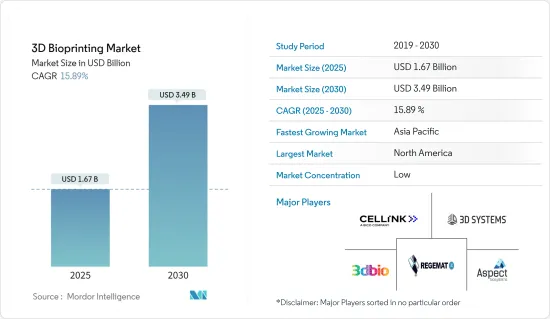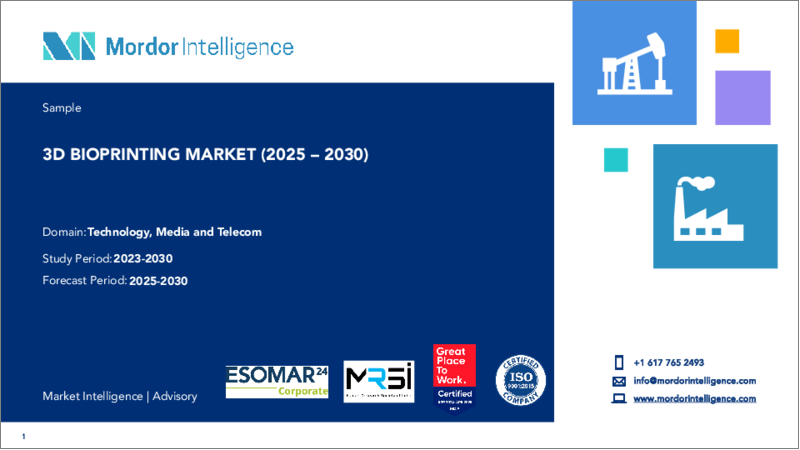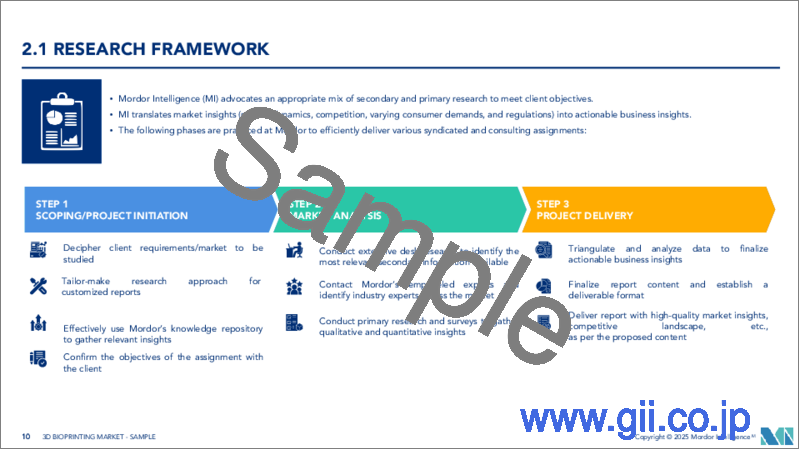|
|
市場調査レポート
商品コード
1640579
3Dバイオプリンティング:市場シェア分析、産業動向・統計、成長予測(2025~2030年)3D Bioprinting - Market Share Analysis, Industry Trends & Statistics, Growth Forecasts (2025 - 2030) |
||||||
カスタマイズ可能
適宜更新あり
|
|||||||
| 3Dバイオプリンティング:市場シェア分析、産業動向・統計、成長予測(2025~2030年) |
|
出版日: 2025年01月05日
発行: Mordor Intelligence
ページ情報: 英文 100 Pages
納期: 2~3営業日
|
全表示
- 概要
- 目次
3Dバイオプリンティング市場規模は、2025年に16億7,000万米ドルと推定され、予測期間(2025-2030年)のCAGRは15.89%で、2030年には34億9,000万米ドルに達すると予測されています。

主なハイライト
- 3Dバイオプリンティングは、バイオインクを使って生きた細胞を層ごとにプリントし、天然組織の挙動や構造を再現します。バイオプリンティングで物質として利用されるバイオインクは、生細胞と混合可能な有機または人工の生体材料で構成されます。この革新的な技術は、組織工学や製薬研究などの分野で活用されており、ヘルスケア分野では急速に導入が進んでいます。
- 技術とバイオプリント構造の活用により、研究者は試験管内で人体の機能性を調べることができます。2D in vitro研究と比較して、3Dバイオプリント構造はより高度な生物学的関連性を提供します。市場開拓は、研究開発への投資の増加、技術の進歩、慢性疾患の有病率の上昇などの要因によってプラスの影響を受けると予想されます。さらに、この技術は、個々の患者の固有の要件を満たすようにカスタマイズされた医療機器やインプラントの設計を容易にします。
- 3Dバイオプリンティングは、組織工学、生物工学、材料科学にさまざまな用途があります。さらに、医薬品の開発や薬剤の検証においても、より頻繁に利用されるようになっています。バイオプリンティング研究は、3Dプリント皮膚、骨移植片、インプラント、さらには完全にプリントされた臓器などの臨床応用に焦点を当てています。これらの製品は、さまざまな臨床や研究の場で利用されています。これらの改良された医療製品は、天然の組織や臓器を複製することはできるが、元の臓器の代わりには適さないです。
- WHOによると、3Dバイオプリンティングは、人間の臓器や組織の修復や置換の必要性など、公衆衛生上の重要な問題に対処する可能性を秘めています。この技術の予想される用途は、研究、訓練、さまざまな医療応用を包含しています。研究開発努力の増加、3Dバイオプリンティングの認知度の上昇、高齢者人口の拡大、先端技術の採用、ヘルスケア支出の増加はすべて、3Dバイオプリンティング市場にプラスに寄与しています。
- 数多くの企業が研究開発に多額の投資を行い、大幅な進歩を遂げ、革新的な製品を発表して技術を強化しています。その一例が、3Dバイオプリンティング分野で米国をリードする医療研究所・研究企業のオルガノボ(Organovo)です。同社は、医薬品の毒性試験用にexVive3D肝組織を製薬会社に提供することで知名度を高めました。メルク社やロレアル社などヘルスケア分野で著名な企業と提携し、現在はexVive3D腎臓組織の発売に向けて準備を進めています。
- 三次元バイオプリンティング技術は、ヘルスケアにおけるさまざまな課題への対応に有望です。例えば、患者の細胞由来のバイオプリント組織から作られた機能的な膀胱は、すでにヒトに効果的に移植されています。科学者たちは、さらなる機能的臓器のバイオプリントの可能性を探求し続けています。さらに、3Dバイオプリンティングの将来的な成果として考えられるのは、患者自身の細胞や幹細胞を土台として、パーソナライズされた人間の臓器を作ることができるため、臓器提供者が不要になることです。
- COVID-19の大流行をきっかけに、3Dプリンティング・コミュニティは立ち上がり、課題に直面していた病院に必要不可欠な医療機器の製造に協力を申し出た。逆に、3Dバイオプリンティングの高価な性質と、この技術を監督する規制の枠組みがないことが、3Dバイオプリンティング市場の成長を阻害すると予想されています。さらに、3Dバイオプリンティングの利用をめぐる社会倫理的問題の増加が、予測期間中に市場に課題をもたらす可能性が高いです。
- COVID-19パンデミックは、サプライチェーンの混乱と治療や材料に対する需要の増加により、医薬品、医療機器、製造技術における技術進歩を著しく促進しました。こうした進歩の1つが3Dバイオプリンティングであり、これは3Dプリンターを用いてカプセル化された細胞やその他の生物学的材料(バイオインク)を配置し、組織、臓器、または組織の成長を促進できる生体適合性の足場を構築するものです。
3Dバイオプリンティング市場動向
薬物検査と開発が大きな市場シェアを占める見込み
- 3Dバイオプリンティング技術は、医薬品試験により正確で効果的な方法を提供するため、医薬品試験・開発の分野は3Dバイオプリンティング技術の導入から大きな恩恵を受ける。動物実験や2D細胞培養などの従来の医薬品試験モデルでは、新薬に対するヒトの反応を正確に予測することには限界があります。一方、3Dバイオプリント組織は、実際の臓器システムや病状を忠実に模倣した、より現実的なモデルを提供し、より迅速で信頼性の高い医薬品スクリーニングや開発手順につながります。
- 3Dプリンティングの目覚ましい進歩は、医薬品への応用に道を開き、患者一人ひとりに合わせた薬剤スクリーニングやドラッグデリバリーシステムの作成を可能にしました。これは、遺伝子組み換え動物実験や大規模生産に大きく依存していた従来の方法とは一線を画すものです。3Dプリンティングは、生体材料を患者固有の細胞に正確に配置することで、現在の薬物スクリーニング・プラットフォームの有効性を高め、その結果、罹患した人体の自然な状態を再現することができます。
- 医薬品開発プロセスは、広範かつ高価で厳しい取り組みですが、新薬を市場に投入するためには不可欠です。通常、創薬の追求において、臨床試験の前に数多くの化合物が複数のスクリーニング段階を経て、最終的に1つの化合物だけが承認を受ける。従来、医薬品のスクリーニングは、疾患モデルとしてトランスジェニック動物に大きく依存してきました。しかし、3Dバイオプリンティングの出現により、医薬品開発の効果を高める新たな技術が開発されつつあります。
- 市場の成長は、安全上の理由から薬物検査を義務付ける政府機関による厳しい規制によって支えられると予想されます。さらに、薬物乱用の監視と対策にますます焦点が当てられており、これが市場の成長にさらに寄与しています。世界の薬物乱用の増加により、薬物検査の需要が高まっています。3Dプリンティング技術の著しい進歩は、医薬品アプリケーションへの道を開き、個々の患者に合わせた薬物スクリーニングやドラッグデリバリーシステムの作成を可能にしています。
- 例えば、2023年12月、米国のバイオテクノロジー企業であるFluidForm Bio社は、freeform reversible embedding of suspended hydrogels(FRESH)3Dバイオプリンティング技術を用いて、ヒト心臓組織の3Dプリンティングに成功しました。ヒト人工多能性幹細胞由来の心筋細胞(hiPSC-CM)を利用することで、FluidFormは医薬品開発を目的としたヒト心臓生理学の正確なモデルを作成することに成功しました。この共同研究には、フルイドフォームとメルク(MSD)の科学者が参加しました。医薬品開発用途の3Dバイオプリンティング分野におけるこのような重要な開発は、市場開拓の原動力となると思われます。
- 製薬会社は医薬品試験にバイオプリント組織を使用しており、開発の初期段階で有望な候補を迅速に特定し、効果のない候補や危険な候補を排除することを可能にしています。このような効率性の向上は、研究開発における大幅なコスト削減につながるだけでなく、革新的な治療法の提供の迅速化にもつながります。慢性疾患の有病率の上昇と、医療分野における安全な医薬品への需要の高まりは、市場の成長をさらに加速させると思われます。さらに、3Dバイオプリンティングの出現により、医薬品開発者は潜在的な合併症を迅速に特定することで、ヒト臨床試験に伴う課題に対処することができます。これらの利点は、医薬品開発アプリケーションにおける市場の拡大をさらに後押しすると期待されています。
アジア太平洋地域が著しい成長を遂げる見込み
- アジア太平洋は3Dバイオプリンティングの急成長市場です。その主な理由は、強力な既存消費者基盤、医療サービスにおける3Dプリンティングの大規模な範囲、3Dプリンティングの研究開発の増加、政府の支援と税制優遇措置です。北米や欧州などの新興経済諸国に比べ、中国における3Dプリンティングの採用は急速に加速しているが、中国がこの技術をいち早く採用したわけではありません。この成長を後押ししている主な要因は、国内の複数のエンドユーザー産業における技術の革新、開発、導入に対する中国政府の支援です。
- 同国では、バイオ製造に関するさまざまな研究も行われています。清華大学(中国・北京)は、積層造形と3Dバイオプリンティングの学際的分野における主要研究所のひとつです。中国科学技術部、中国国家自然科学基金、中国国家衛生委員会、北京市科学技術委員会の後援を受けた清華大学のバイオマニュファクチャリングセンターは、バイオマテリアル、生きた細胞、タンパク質、その他の生物学的化合物を、バイオミメティック構造を作製するための基本的な構成要素として扱う研究に非常に力を入れています。この調査は、組織工学、再生医療、疾病発症、薬物スクリーニング、組織・臓器チップなど、さまざまな分野で応用されています。
- 中国の科学者たちは、3Dバイオプリンティングの分野で、特に液中印刷法で大きな進歩を遂げました。液体ポリマーを利用することで、液体が接触したときに耐久性のある膜を形成する技術を開発しました。これらの液体構造体は、最終的に合体するまでの10日間、その形状を維持するという驚くべき能力を持っています。この革新的なアプローチは、複雑な形状のプリントを可能にし、生きた細胞を用いて複雑な3Dプリント組織を作る可能性を開く。
- インドでは、インド科学研究所(IISc)、インド工科大学(IITs)、国立工科大学(NITs)、Sree Chitra Tirunal Institute for Medical Sciences and Technology(SCTIMST)、その他の大学などの学術研究機関を中心に、3Dバイオプリンティングの概念が徐々に浸透しつつあります。Dバイオプリンターの開発で著名なCELLINK社とIIScの協力は、3Dバイオプリンティング技術の進歩をさらに推進しました。この提携により、ベンガルールに3Dバイオプリンティングのためのセンター・オブ・エクセレンス(CoE)が設立され、市場が大きく活性化しました。
- インド・ブランド・エクイティ財団によると、ヘルスケア分野は国内で最も急成長している分野のひとつです。最近の予算では、インドの医療への公的支出は対GDP比で1.2%でした。インド政府は、2025年までに公的医療支出をGDPの2.5%まで増やす計画です。ヘルスケア分野のこうした動向は、同国の市場成長を大きく後押しすると期待されています。
- インドの新興企業の多くは、革新的なソリューションを通じてバイオプリンティング技術を普及させています。例えば、BITSピラニとゴアの学生によって設立されたBiop社は、3Dバイオプリンティングの装置と技術を製造することで、医学研究を変えることを目指しています。この製品は、センサー、アクチュエーター、UV技術を使って3Dバイオプリンティングを制御し、ワンクリックで人体組織を形成することができます。同社はマサチューセッツ工科大学(MIT)やハーバード大学と協力しました。新興企業の成長、高齢者人口の増加、がん患者の増加が、予測期間中の市場成長を促進する重要な要因の一つです。
- Pandorum Technologiesの報告によると、インドでは2023年3月に新薬と臨床試験の規則が改正され、研究者は新薬の安全性と有効性を評価するために別の方法を採用できるようになった。この改正は、近年インドで大きな成長を遂げている3Dバイオプリンティングの開発を大きく促進する可能性があります。同社によると、2024年1月現在、2023年改正により、様々な手間のかかる前臨床試験や動物実験の代替として、3Dバイオプリンティング組織の利用が認められています。受託研究機関はすでに、3Dバイオプリント角膜を用いた前臨床薬剤試験を実施しています。
- 日本政府は、再生医療産業が2030年までに1兆円の売上を記録すると予測しています。新エネルギー・産業技術総合開発機構(NEDO)は、3Dバイオプリンティングのような新興・革新技術が近い将来市場をリードする可能性があると予想しています。
3Dバイオプリンティング産業の概要
3Dバイオプリンティング市場の競争は激しいです。大小さまざまなプレーヤーが存在するため、市場は集中しています。同市場の主要企業には、3D Systems Corporation、Aspect Biosystems Ltd、GeSIM GmbH、Cellink AB、Cyfuse Biomedical KK、Envision TEC GmbHなどがあります。
- 2024年5月Nanoscribe社とAdvanced BioMatrix社は、2光子重合(2PP)ベースの3Dプリンティング用に特別に設計された4種類の最先端のバイオレジンを導入することで、バイオプリンティングの分野をリードするために提携しました。この提携は、高精度3Dプリンティングにおけるナノスクライブの広範な知識と、生体材料の開発におけるアドバンスト・バイオマトリックスの専門知識を結集し、バイオプリンティング能力を大幅に向上させることを目的としています。これらの画期的なバイオレジンは、比類のない精度、解像度、適応性を提供し、ライフサイエンスおよびバイオメディカル分野における探求と進歩の新たな道を開き、最終的には人類の健康の進歩に貢献します。
- 2023年9月CELLINKはParalab社と戦略的販売代理店契約を締結し、ポルトガルとスペインにおける事業の顕著な成長を意味します。この提携により、CELLINKは先進的なバイオプリンティング・ソリューションを提供することで、南欧州でより多くの人々にアプローチできるようになると期待されています。そうすることで、同社は、この地域の特性を考慮しながら再生医療を発展させることに専念することを再確認しました。今回の提携は、知識、トレーニング、技術サポートの交換を優先し、ポルトガルとスペインの研究者がCELLINK社の最先端バイオプリンティングプラットフォームを効果的に利用できるようにするものです。
その他の特典
- エクセル形式の市場予測(ME)シート
- 3ヶ月間のアナリストサポート
目次
第1章 イントロダクション
- 調査の前提条件と市場定義
- 調査範囲
第2章 調査手法
第3章 エグゼクティブサマリー
第4章 市場洞察
- 市場概要
- 業界の魅力度-ポーターのファイブフォース分析
- 供給企業の交渉力
- 消費者の交渉力
- 新規参入業者の脅威
- 代替品の脅威
- 競争企業間の敵対関係
- COVID-19の3Dバイオプリンティング市場への影響
第5章 市場力学
- 市場促進要因
- 老人人口の増加
- 研究開発投資の増加
- 市場の課題
- 運営上の課題
第6章 市場セグメンテーション
- 技術別
- シリンジ/押出バイオプリンティング
- インクジェットバイオプリンティング
- 磁気浮上バイオプリンティング
- レーザー支援バイオプリンティング
- その他の技術
- コンポーネント別
- 3Dバイオプリンター
- バイオマテリアル
- 足場
- 用途別
- 医薬品試験・開発
- 再生医療
- 食品検査
- 調査
- その他の用途
- 地域別
- 北米
- 米国
- カナダ
- 欧州
- 英国
- ドイツ
- フランス
- その他欧州
- アジア太平洋
- 中国
- 日本
- インド
- その他アジア太平洋地域
- 世界のその他の地域
- 北米
第7章 競合情勢
- 企業プロファイル
- Cellink
- 3D Systems Corporation
- 3D Bioprinting Solutions
- REGEMAT 3D
- Aspect Biosystems Ltd
- Cyfuse Biomedical KK
- Envision TEC GmbH
- Organovo Holdings Inc.
- RegenHU SA
- Stratasys Ltd
- GeSIM GmbH
- Arcam AB(GE Company)
第8章 投資分析
第9章 市場の将来
The 3D Bioprinting Market size is estimated at USD 1.67 billion in 2025, and is expected to reach USD 3.49 billion by 2030, at a CAGR of 15.89% during the forecast period (2025-2030).

Key Highlights
- 3D bioprinting involves using bio-inks to print living cells in a layer-by-layer process, replicating the behavior and structures of natural tissues. Bioinks, utilized as a substance in bioprinting, consist of organic or artificial biomaterials that can be blended with viable cells. This innovative technology is utilized in fields like tissue engineering and pharmaceutical research, with the healthcare sector poised to embrace it rapidly.
- The utilization of technology and bioprinted structures allows researchers to examine the functionalities of the human body in vitro. In comparison to 2D in vitro studies, 3D bioprinted structures offer a higher level of biological relevance. The market growth is expected to be positively influenced by factors such as increased investment in research and development, advancements in technology, and the rising prevalence of chronic diseases. Additionally, this technology facilitates the design of personalized medical devices and implants tailored to meet the unique requirements of individual patients.
- 3D bioprinting has various applications in tissue engineering, bioengineering, and materials science. Additionally, it is being utilized more frequently in pharmaceutical development and drug validation. Bioprinting research focuses on clinical applications like 3D printed skin, bone grafts, implants, and even fully printed organs. These products are utilized in various clinical and research settings. While these modified medical products can replicate natural tissues and organs, they are not suitable as replacements for the original organs.
- According to WHO, 3D bioprinting has the potential to address important public health issues, like the need for human organ and tissue repair or replacement. The anticipated uses of this technology encompass research, training, and a variety of medical applications. The increase in research and development efforts, the rise in awareness of 3D bioprinting, the expanding elderly population, the adoption of advanced technologies, and the growth in healthcare spending all contribute positively to the 3D bioprinting market.
- Numerous enterprises are investing heavily in research and development to enhance technology by making significant advancements and introducing innovative products. One such example is Organovo, a medical laboratory and research firm leading the way in the United States in the field of 3D bioprinting. The company gained recognition by providing pharmaceutical companies with its exVive3D Liver Tissue for testing medicine toxicity. It has partnered with notable companies like Merck and L'Oreal in the healthcare sector and is now gearing up to launch its exVive3D Kidney Tissue product.
- Three-dimensional bioprinting technology holds promise in addressing various challenges in healthcare. For instance, functional bladders created from bioprinted tissue derived from patients' cells have already been effectively transplanted into humans. Scientists are continuously exploring the potential of bioprinting additional functional organs. Additionally, a potential future outcome of 3D bioprinting is the elimination of the need for organ donors, as personalized human organs can be produced using the patient's own cells or stem cells as a foundation.
- The COVID-19 pandemic prompted the 3D printing community to step up and offer their assistance in manufacturing essential medical equipment for hospitals that were facing challenges. Conversely, the expensive nature of 3D bioprinting and the absence of regulatory frameworks overseeing this technology are anticipated to impede the growth of the 3D bioprinting market. Moreover, the increasing socioethical issues surrounding the utilization of 3D bioprinted items are likely to pose a challenge to the market during the forecast period.
- The COVID-19 pandemic significantly expedited technological advancements in pharmaceuticals, medical devices, and manufacturing technologies due to disrupted supply chains and increased demand for treatments and materials. One of these advancements was 3D bioprinting, which involves arranging encapsulated cells or other biological materials (bio-inks) using a 3D printer to build tissue, organs, or biocompatible scaffolds that can enhance tissue growth.
3D Bioprinting Market Trends
Drug Testing and Development Are Expected to Hold a Significant Market Share
- The field of drug testing and development greatly benefits from the implementation of 3D bioprinting technologies as they offer more precise and effective methods for pharmaceutical testing. Conventional drug testing models, such as animal testing and 2D cell cultures, have limitations in accurately predicting human reactions to new medications. On the other hand, 3D bioprinted tissues offer more realistic models that closely mimic actual organ systems and disease conditions, leading to faster and more dependable drug screening and development procedures.
- The remarkable advancement of 3D printing has paved the way for pharmaceutical applications, allowing for the creation of personalized drug screening and drug delivery systems tailored to each patient. This marks a departure from traditional methods that heavily depended on transgenic animal experiments and large-scale production. 3D printing enhances the effectiveness of current drug screening platforms by precisely placing biomaterials with patient-specific cells, thus replicating the natural conditions of the afflicted human body.
- The drug development process is an extensive, expensive, and demanding endeavor, but it is essential for introducing a new medication to the market. Typically, numerous compounds undergo multiple screening stages prior to clinical trials in the pursuit of drug discovery, and ultimately, only one compound receives approval. Traditionally, drug screening has heavily relied on transgenic animals as disease models. However, with the emergence of 3D bioprinting, new techniques are being developed to enhance the effectiveness of drug development.
- The market growth is expected to be supported by strict regulations imposed by government agencies, which require drug testing for safety reasons. Additionally, there is an increasing focus on monitoring and combating substance abuse, which further contributes to the market's growth. The rising prevalence of substance abuse worldwide has led to higher demand for drug testing. The significant advancements in 3D printing technology have paved the way for pharmaceutical applications, allowing the creation of personalized drug screening and drug delivery systems for individual patients.
- For instance, in December 2023, FluidForm Bio, a US biotechnology company, made progress in 3D-printing human cardiac tissue using freeform reversible embedding of suspended hydrogels (FRESH) 3D bioprinting technology. By utilizing human induced pluripotent stem cell-derived cardiomyocytes (hiPSC-CMs), FluidForm managed to create an accurate model of human cardiac physiology for drug development purposes. This collaborative study involved scientists from FluidForm and Merck (MSD). Such significant developments in the field of 3D bioprinting for drug development applications will drive the market's growth.
- Pharmaceutical companies are using bioprinted tissues for drug testing, enabling them to swiftly identify promising candidates and eliminate ineffective or hazardous ones at an early stage of development. This enhanced efficiency can lead to substantial cost savings in research and development, as well as expedite the availability of innovative therapies. The rising prevalence of chronic diseases and the increasing demand for safe medications within the medical sector will further fuel the market's growth. Additionally, the emergence of 3D bioprinting allows drug developers to address the challenges associated with human clinical trials by promptly identifying potential complications. These advantages are expected to further bolster the market's expansion in drug development applications.
Asia-Pacific is Expected to Witness Significant Growth
- Asia-Pacific is the fastest-growing market for 3D bioprinting, mainly due to a strong existing consumer base, the massive scope of 3D printing in medical services, increasing R&D for 3D printing, and government support and tax incentives. The adoption of 3D printing in China is rapidly picking pace compared to other developed economies, such as North America and Europe, though it was not among the earliest adopters of the technology. The primary factor driving this growth is the support from the Chinese government in the innovation, development, and adoption of the technology across several end-user industries in the country.
- The country also witnessed various kinds of research in bio-manufacturing. Tsinghua University (Beijing, China) is one of the leading laboratories in the interdisciplinary field of additive manufacturing and 3D bioprinting. Sponsored by the Ministry of Science and Technology of China, the National Natural Science Foundation of China, the National Health Commission of China, and the Beijing Municipal Science & Technology Commission, its bio-manufacturing center is highly dedicated to conducting research involving biomaterials, living cells, proteins, and other biological compounds, as basic building blocks to fabricate biomimetic structures. This research finds applications in various areas, such as tissue engineering, regenerative medicine, disease pathogenesis, drug screening, and tissue/organ-on-a-chip.
- Chinese scientists have made significant progress in the field of 3D bioprinting, particularly with the liquid-in-liquid printing method. By utilizing liquid polymers, they have developed a technique that forms a durable membrane when the liquids come into contact. These liquid structures have the remarkable ability to maintain their shape for up to 10 days before eventually merging. This innovative approach enables the printing of intricate shapes and opens up possibilities for creating complex 3D-printed tissues using living cells.
- In India, the concept of 3D bioprinting is gradually gaining traction, with a focus on academic and research labs such as the Indian Institute of Science (IISc), Indian Institutes of Technology (IITs), National Institutes of Technology (NITs), Sree Chitra Tirunal Institute for Medical Sciences and Technology (SCTIMST), and other universities. The collaboration between CELLINK, a prominent player in the development of 3D bioprinters, and IISc further propelled the advancement of 3D bioprinting technology. This partnership led to the establishment of a Centre of Excellence (CoE) for 3D bioprinting in Bengaluru, providing a significant boost to the market.
- According to the Indian Brand Equity Foundation, the healthcare sector is one of the fastest-growing in the country. In the recent budget, India's public expenditure on healthcare stood at 1.2% as a percentage of the GDP. The Government of India plans to increase public health spending to 2.5% of the GDP by 2025. Such trends in the healthcare sector are expected to boost the country's market growth significantly.
- Many Indian start-ups are making bioprinting technology popular through innovative solutions. For instance, Biop, established by BITS Pilani and Goa students, aims to change medical research by manufacturing the equipment and technology for 3D bioprinting. The product can form human tissues with one click, using sensors, actuators, and UV technology to control the 3D bioprinting. The company collaborated with MIT and Harvard. The growth of start-ups, as well as the increasing elderly population and cancer cases, is among the significant factors set to fuel the market's growth over the forecast period.
- Pandorum Technologies reported that since India revised its New Drugs and Clinical Trial Rules in March 2023, researchers can employ alternative methods for assessing the safety and efficacy of new medications. This amendment has the potential to greatly enhance the development of 3D bioprinting, a field that has seen significant growth in India in recent years. According to the company, as of January 2024, the 2023 amendment permitted the utilization of 3D bioprinted tissues as a substitute for various laborious preclinical or animal studies. Contract research organizations have already conducted preclinical drug tests on 3D bioprinted corneas.
- The Japanese government estimates that the regenerative medicine industry will record a revenue of JPY 1 trillion by 2030. The New Energy and Industrial Technology Development Organization (NEDO) expects that emerging and innovative technologies, such as 3D bioprinting, may lead the market in the near future.
3D Bioprinting Industry Overview
The 3D bioprinting market is very competitive in nature. The market is concentrated due to the presence of various small and large players. Some of the significant players in the market are 3D Systems Corporation, Aspect Biosystems Ltd, GeSIM GmbH, Cellink AB, Cyfuse Biomedical KK, and Envision TEC GmbH.
- May 2024: Nanoscribe and Advanced BioMatrix collaborated to lead the way in the field of bioprinting by introducing four cutting-edge bioresins designed specifically for Two-Photon Polymerization (2PP) based 3D printing. This partnership brings together Nanoscribe's extensive knowledge in highly accurate 3D printing and Advanced BioMatrix's expertise in developing biomaterials, with the goal of greatly improving bioprinting capabilities. These groundbreaking bioresins offer unparalleled precision, resolution, and adaptability, opening up new avenues for exploration and advancement in the life sciences and biomedical sectors and ultimately contributing to the progress of human health.
- September 2023: CELLINK entered into a strategic distribution agreement with Paralab, which signified a notable growth in its operations in Portugal and Spain. This partnership was expected to enable CELLINK to reach a wider audience in Southern Europe by offering advanced bioprinting solutions. By doing so, the company reaffirmed its dedication to advancing regenerative medicine while taking into account the specific characteristics of the region. The collaboration will prioritize the exchange of knowledge, training, and technical support, ensuring that researchers in Portugal and Spain can effectively utilize CELLINK's state-of-the-art bioprinting platforms.
Additional Benefits:
- The market estimate (ME) sheet in Excel format
- 3 months of analyst support
TABLE OF CONTENTS
1 INTRODUCTION
- 1.1 Study Assumptions and Market Definition
- 1.2 Scope of the Study
2 RESEARCH METHODOLOGY
3 EXECUTIVE SUMMARY
4 MARKET INSIGHTS
- 4.1 Market Overview
- 4.2 Industry Attractiveness - Porter's Five Forces Analysis
- 4.2.1 Bargaining Power of Suppliers
- 4.2.2 Bargaining Power of Consumers
- 4.2.3 Threat of New Entrants
- 4.2.4 Threat of Substitutes
- 4.2.5 Intensity of Competitive Rivalry
- 4.3 Impact of COVID-19 on the 3D Bioprinting Market
5 MARKET DYNAMICS
- 5.1 Market Drivers
- 5.1.1 Increasing Geriatric Population
- 5.1.2 Increasing Investments in R&D
- 5.2 Market Challenges
- 5.2.1 Operational Challenges
6 MARKET SEGMENTATION
- 6.1 By Technology
- 6.1.1 Syringe/Extrusion Bioprinting
- 6.1.2 Inkjet Bioprinting
- 6.1.3 Magnetic Levitation Bioprinting
- 6.1.4 Laser-assisted Bioprinting
- 6.1.5 Other Technologies
- 6.2 By Component
- 6.2.1 3D Bioprinters
- 6.2.2 Biomaterials
- 6.2.3 Scaffolds
- 6.3 By Application
- 6.3.1 Drug Testing and Development
- 6.3.2 Regenerative Medicine
- 6.3.3 Food Testing
- 6.3.4 Research
- 6.3.5 Other Applications
- 6.4 By Geography
- 6.4.1 North America
- 6.4.1.1 United States
- 6.4.1.2 Canada
- 6.4.2 Europe
- 6.4.2.1 United Kingdom
- 6.4.2.2 Germany
- 6.4.2.3 France
- 6.4.2.4 Rest of Europe
- 6.4.3 Asia-Pacific
- 6.4.3.1 China
- 6.4.3.2 Japan
- 6.4.3.3 India
- 6.4.3.4 Rest of Asia-Pacific
- 6.4.4 Rest of the World
- 6.4.1 North America
7 COMPETITIVE LANDSCAPE
- 7.1 Company Profiles
- 7.1.1 Cellink
- 7.1.2 3D Systems Corporation
- 7.1.3 3D Bioprinting Solutions
- 7.1.4 REGEMAT 3D
- 7.1.5 Aspect Biosystems Ltd
- 7.1.6 Cyfuse Biomedical KK
- 7.1.7 Envision TEC GmbH
- 7.1.8 Organovo Holdings Inc.
- 7.1.9 RegenHU SA
- 7.1.10 Stratasys Ltd
- 7.1.11 GeSIM GmbH
- 7.1.12 Arcam AB (GE Company)






